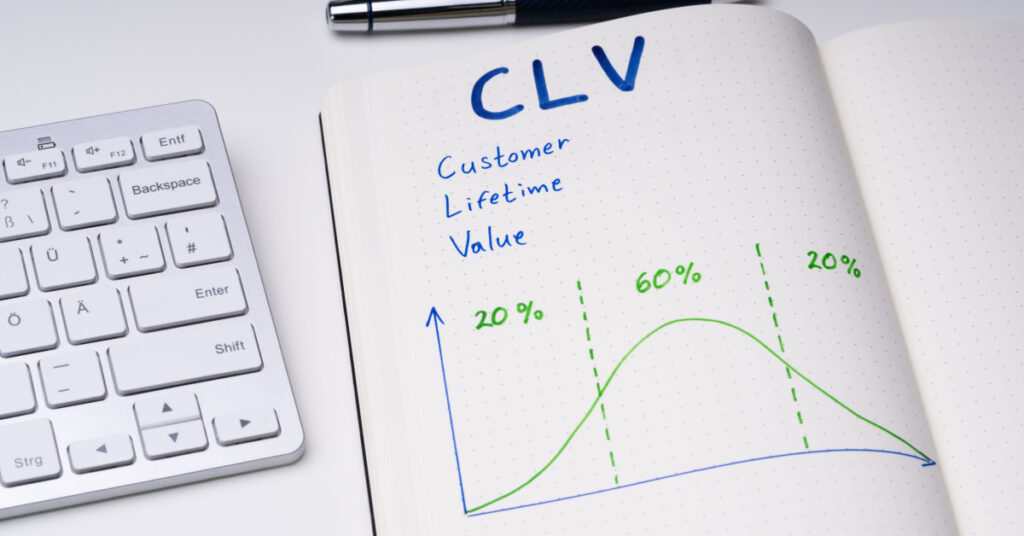How to Calculate Customer Lifetime Value for B2B Marketing


Customer lifetime value (CLV) is figuring out what you’re actually gaining from each customer. Use this metric to get the pulse of your business.
The true value of a customer is not just the size of the deal. Calculating customer lifetime value is a more reliable measure of the ROI of your sales and retention motions. Researchers estimate that today it costs five times as much to acquire a new customer than it does to retain a current one. In other words, customer satisfaction and customer retention are crucial to calculating the lifetime value of a customer’s business.

A customer lifetime value formula is a foundational metric that can transform your marketing.
It’s useful to ask if you are making money, of course, but this formula also addresses practical questions every B2B marketer should be able to answer:
- Are you finding your most valuable customers?
- Are you targeting them effectively with your marketing?
- Are you making the most of the relationship once you win their business?
In this blog we’ll cover these and other common questions about customer lifetime value calculation. We’ll also explain how to use customer lifetime value to assess marketing effectiveness, diagnose common problems, and make smarter decisions.
What is Customer Lifetime Value?
Customer lifetime value is the total amount of revenue that you will receive over the course of your relationship with a specific customer. It hinges on how long, on average, you are able to keep customers.
Customer lifetime value is the key to figuring out what you’re actually gaining from each customer. If you’re great at getting deals to close and you’re making all of your monthly revenue goals, that’s fantastic. But if you’re having trouble retaining those customers that you worked so hard to get, you’re likely making much less revenue from each customer than you potentially could. The amount of money you’re truly getting out those deals is small, even if there are a lot of them. And depending on your business model, you might not see net profit on a customer until you’ve had them for a cycle or two.
How do you calculate CLV?
Start with three questions that every B2B marketing organization should be able to answer (or at least know where to find the answer):
- What is the average sales value of your first transaction with a customer?
- How much do you typically make per year from a customer after the first purchase? (including cross-sell and upsell revenue)
- How long does a typical customer continue to do business with you?
For example, a typical first sale of $20,000, a typical ongoing annual value of $5,000 and a typical customer lifespan of five years (or 5 * $5,000), yields a customer lifetime value of $45,000.
This formula can get much more complicated. Some marketers use net profit instead of simple revenue, apply a rate of discount to capture today’s value of future customer purchases, or factor interest into the equation.

So you’ve made your customer lifetime value calculation: how do you know if it’s good or bad?
How do I know whether my customer lifetime value is good or bad?
Ask yourself these questions:
- How much did you spend to acquire a customer?
- Do you typically generate significant revenue from return/repeat customers?
- How much do you typically spend to maintain these ongoing customer relationships?
Often, marketers calculate customer lifetime value based only upon the value of the first sale, underestimating the total value of the customer. Much of the value marketers get from calculating customer lifetime value comes from tracking the impact of ongoing marketing campaigns, customer service interactions, upsell & cross-sell programs, and other tactics designed to increase revenue. When you base customer lifetime value entirely on the first sale, you lose the ability to measure the success of these activities.
CLV simply lets you see clearly what you’re getting out of a customer versus what you’ve put in. Having insight into your revenue streams can help you dictate your go-to-market strategy. Additionally, CLV helps you answer one of the most important questions anyone can ask about a business: Did it make more money from a customer than it spent to acquire that customer?
How can I use CLV to make my marketing more effective?
A complete view of customer lifetime value allows you to track the impact of your customer onboarding, retention, upsell & cross-sell efforts, and loyalty programs. You can pull each of those levers, assess the results, and decide where to focus future efforts and investment.
Customer lifetime value has long been used to determine not just campaign effectiveness, but also to determine how much should be spent on marketing, on media buys, and other marketing investments. Marketers also work very hard to increase the value of a customer’s initial purchase. You don’t need a customer lifetime value to do that necessarily; average revenue per customer tells the story. Changes in initial deal value, however, often interact in interesting ways with changes in long-term customer value.
Connecting customer lifetime value with ideal customer profile
You can also use customer lifetime value to define your ideal customer profile, and pursue more customers that fit that profile. To do so, first identify and segment your ICP customers based on whatever metrics work for you and your business (industry, company size, etc.). Then, compare the customer lifetime value for that segment to your CLV on the whole. The difference should help you invest more in your ideal customers, or make the case to your leadership team that you need to do so.
Finally, a clear view of customer lifetime value allows marketers to spot and fight back against “sloppy growth.” This is often a problem when marketers choose high-volume lead-gen tactics without considering where and how to protect lead quality. Often, these customers are the inverse image of a company’s “best customer” segment: They buy less initially, spend less after the first purchase, and are less likely to renew. Falling lifetime value is a signal to adjust your lead-gen programs to target your ideal customer more carefully.

Calculating customer lifetime value can unlock huge potential for marketing and sales.
Customer lifetime value can help you craft an accurate budget
According to Ruth Stevens, President of eMarketing Strategy, “The expected lifetime value of a customer represents the maximum allowable acquisition cost of that customer. Then using those numbers, you can craft a marketing budget that is related to firm profitability versus some fussier method of budgeting for marketing expenses.”
The more predictable your revenue streams are, the better. If you know exactly how much money will be flowing through your company this year, next year, and beyond, you’re already off to a good start for budgeting and creating sustainable growth.
Marketing automation and lifetime value
Marketing automation reports and dashboards make it quick and convenient to review and analyze tons of customer intelligence, including demographics, campaign engagement, website visits, and purchase history. This information – often available in real time – is helpful for identifying cross-selling and upselling opportunities – great ways to increase the value of your customers! Behavior history profiles can also uncover likely follow-up sale products based on each customer’s pre-purchase and post-purchase interactions.
Learn more about how Act-on can help you improve your marketing, sales, and product development strategies.
Want more like this?
Want more like this?
Insight delivered to your inbox
Keep up to date with our free email. Hand picked whitepapers and posts from our blog, as well as exclusive videos and webinar invitations keep our Users one step ahead.
By clicking 'SIGN UP', you agree to our Terms of Use and Privacy Policy


By clicking 'SIGN UP', you agree to our Terms of Use and Privacy Policy
Other content you may be interested in
Categories
Categories
Categories

Want more like this?


Want more like this?
Insight delivered to your inbox
Keep up to date with our free email. Hand picked whitepapers and posts from our blog, as well as exclusive videos and webinar invitations keep our Users one step ahead.
By clicking 'SIGN UP', you agree to our Terms of Use and Privacy Policy









